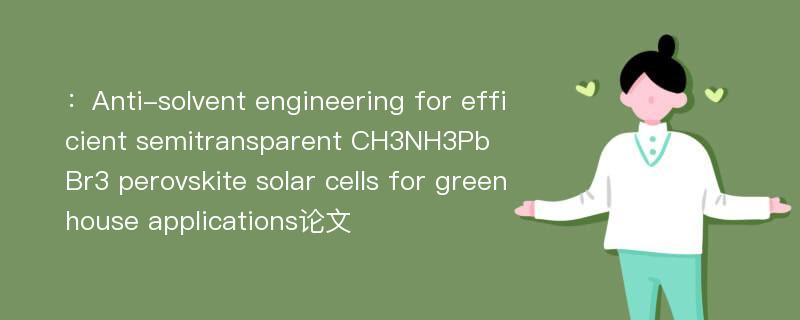
本文主要研究内容
作者(2019)在《Anti-solvent engineering for efficient semitransparent CH3NH3PbBr3 perovskite solar cells for greenhouse applications》一文中研究指出:With ideal combination of benefits that selectively converts high photon energy spectrum into electricity while transmitting low energy photons for photosynthesis, the CH3NH3PbBr3 perovskite solar cell(BPSC)is a promising candidate for efficient greenhouse based building integrated photovoltaic(BIPV) applications. However, the efficiency of BPSCs is still much lower than their theoretical efficiency. In general, interface band alignment is regarded as the vital factor of the BPSCs whereas only few reports on enhancing perovskite film quality. In this work, highly efficient BPSCs were fabricated by improving the crystallization process of CH3NH3PbBr3 with the assistance of anti-solvents. A new anti-solvent of diphenyl ether(DPE) was developed for its strong interaction with the solvents in the perovskite precursor solution. By using the anti-solvent of DPE, trap-state density of the CH3NH3PbBr3 film is reduced and the electron lifetime is enhanced along with the large-grain crystals compared with the samples from conventional anti-solvent of chlorobenzene. Upon preliminary optimization, the efficiencies of typical and semitransparent BPSCs are improved to as high as 9.54% and 7.51%, respectively. Optical absorption measurement demonstrates that the cell without metal electrode shows 80% transparency in the wavelength range of 550–1000 nm that is perfect for greenhouse vegetation. Considering that the cell absorbs light in the blue spectrum before 550 nm, it offers very high solar cell efficiency with only 17.8% of total photons,while over 60% of total photons can transmit through for photosynthesis if a transparent electrode can be obtained such as indium doped SnO2.
Abstract
With ideal combination of benefits that selectively converts high photon energy spectrum into electricity while transmitting low energy photons for photosynthesis, the CH3NH3PbBr3 perovskite solar cell(BPSC)is a promising candidate for efficient greenhouse based building integrated photovoltaic(BIPV) applications. However, the efficiency of BPSCs is still much lower than their theoretical efficiency. In general, interface band alignment is regarded as the vital factor of the BPSCs whereas only few reports on enhancing perovskite film quality. In this work, highly efficient BPSCs were fabricated by improving the crystallization process of CH3NH3PbBr3 with the assistance of anti-solvents. A new anti-solvent of diphenyl ether(DPE) was developed for its strong interaction with the solvents in the perovskite precursor solution. By using the anti-solvent of DPE, trap-state density of the CH3NH3PbBr3 film is reduced and the electron lifetime is enhanced along with the large-grain crystals compared with the samples from conventional anti-solvent of chlorobenzene. Upon preliminary optimization, the efficiencies of typical and semitransparent BPSCs are improved to as high as 9.54% and 7.51%, respectively. Optical absorption measurement demonstrates that the cell without metal electrode shows 80% transparency in the wavelength range of 550–1000 nm that is perfect for greenhouse vegetation. Considering that the cell absorbs light in the blue spectrum before 550 nm, it offers very high solar cell efficiency with only 17.8% of total photons,while over 60% of total photons can transmit through for photosynthesis if a transparent electrode can be obtained such as indium doped SnO2.
论文参考文献
论文详细介绍
论文作者分别是来自Journal of Energy Chemistry的,发表于刊物Journal of Energy Chemistry2019年07期论文,是一篇关于,Journal of Energy Chemistry2019年07期论文的文章。本文可供学术参考使用,各位学者可以免费参考阅读下载,文章观点不代表本站观点,资料来自Journal of Energy Chemistry2019年07期论文网站,若本站收录的文献无意侵犯了您的著作版权,请联系我们删除。
